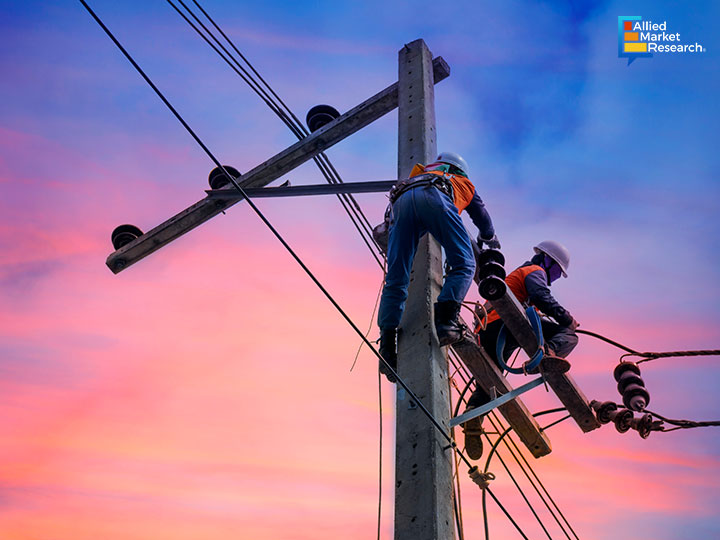Understanding Electrical Power Poles: Functions, Materials, and Industry Developments

2 Jul
2025
Highlights:
- Introduction
- Fire-resistant, stronger poles
- Poles with smart tech support
Electric power poles are an essential part of any electrical distribution system. From supporting overhead power lines to carrying transformers and streetlights, these structures form the visible backbone of energy infrastructure in cities and rural areas alike. Even though often overlooked, the components, materials, and design of these poles directly impact power reliability, installation costs, and long-term maintenance efforts. Recently, changes in material choices, weather protection needs, and grid upgrades have steadily driven the industry's growth.
The Role of Power Poles in Electrical Distribution
Electrical power poles are designed to hold and support distribution lines at a safe height above the ground. Their role is to maintain proper spacing between the lines and prevent contact with other physical objects, wildlife, or people. These poles are not only load-bearing but also need to endure different environmental conditions, such as strong winds, heavy rain, snow, and extreme heat. Their reliability is highly essential because even a single pole failure can disrupt entire circuits, causing localized or widespread power outages.
In addition to lines, poles also carry key hardware components such as insulators, crossarms, fuses, lightning arresters, and reclosers. Some poles are configured to hold transformers that step down high-voltage electricity for safe use in homes and businesses. The design and height of a power pole depend on the number of circuits it carries, voltage levels, and terrain. Utility engineers need to assess all these variables while planning pole installations.
Choosing the Right Material for the Job
One of the most discussed aspects in the electrical utility field is the choice of material for pole construction. Traditionally, wood has been the most used material, especially in North America and parts of Asia. Wooden poles are relatively inexpensive and easy to climb or modify, but they are vulnerable to rot, termites, and fire. To extend their lifespan, they are often treated with preservatives like creosote or pentachlorophenol. However, concerns over chemical treatment residues and disposal issues have led to increased scrutiny.
In recent years, the use of steel and concrete poles has gained attention due to their durability and lower maintenance needs. Steel poles are lighter than concrete, offer higher strength-to-weight ratios, and are easier to install with pre-drilled holes. They also perform better during storms and resist fire damage, which is a growing concern in areas prone to wildfires. Concrete poles, while heavy and harder to transport, provide exceptional strength and are often used in regions facing high winds and hurricanes.
Composite poles made from fiber-reinforced polymer are also being considered in certain specialized applications. These poles are non-conductive, corrosion-resistant, and lighter than both steel and concrete. Although they come at a higher upfront cost, utilities are exploring them as long-term solutions for remote or harsh environments. According to Allied Market Research, the electrical power pole industry accounted for $12.9 billion in 2024 and is expected to reach $21.9 billion by 2034, citing a CAGR of 5.5% during 2025-2034.
Recent Events and Advancements in the Corner
Following the rise in wildfire incidents across parts of the western United States and Australia, utilities have begun replacing old wooden poles with steel or composite alternatives. In April 2025, California-based Pacific Gas and Electric (PG&E) announced progress in its ongoing wildfire mitigation plan by installing over 4,500 steel poles in high fire-risk zones, replacing traditional wood poles as part of grid hardening initiatives.
The growing use of distributed energy resources such as rooftop solar and battery storage has created a demand for poles that can support heavier equipment. Today’s poles are designed to carry not just power lines but also sensors, communication devices, and even 5G equipment used in smart grid systems. This added weight demands advanced structural analysis and often leads to new pole specifications, particularly in space-constrained urban areas.
Moreover, global supply chain disruptions have impacted material costs and delivery timelines for pole manufacturers. Delays in steel and resin availability have encouraged utilities to diversify suppliers or consider hybrid pole structures using multiple materials. Several utility companies are also investing in advanced modeling software to predict pole performance under various environmental stressors, aiming to avoid failures and improve inspection planning.
Final Thoughts
Electrical power poles often seem like simple structures, but their design, material, and location play a big role in keeping electricity flowing reliably. With increasing pressure from climate change, changing regulations, and new grid technologies, the industry has adapted how it approaches pole construction and maintenance. The focus is now on making poles stronger, smarter, and safer to meet the changing needs of energy infrastructure. Whether through material innovation or structural upgrades, these unassuming towers are likely to remain essential in delivering electricity to the last mile.
Reach out to our team of experts to gain deeper insights into the evolving landscape of the electrical power pole industry.

Koyel Ghosh
Author’s Bio- Koyel Ghosh is a blogger with a strong passion and enjoys writing in miscellaneous domains, as she believes it lets her explore a wide variety of niches. She has an innate interest in creativity and enjoys experimenting with different writing styles. A writer who never stops imagining, she has been serving the corporate industry for the last five years.
Avenue: Entire Library membership of Allied Market Research Reports at your disposal
- Avenue is an innovative subscription-based online report database.
- Avail an online access to the entire library of syndicated reports on more than 2,000 niche industries and company profiles on more than 12,000 firms across 11 domains.
- A cost-effective model tailored for entrepreneurs, investors, and students & researchers at universities.
- Request customizations, suggest new reports, and avail analyst support as per your requirements.
- Get an access to the library of reports at any time from any device and anywhere.
Related Post
-
How are Submarine Cables Transforming Global Connectivity with Enhanced User Experience?
-
Endoscopy Procedures: Transformations in Techniques and Applications
-
AI-Powered Video Analytics: How the Product Actually Works for enterprises
-
Painting Robots: Transforming Precision Coating and Creative Applications
-
Innovations in Pharmacovigilance Systems Advancing Patient Safety
-
Understanding Edge Security: Keeping Data Safe Near the Source
-
Exploring the Use and Advancements of 3D Laser Scanners in Professional Applications
-
Reinforcing Industrial Controls with Smarter Tools and Training








